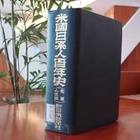Oregon, on the Pacific coast, is located between Washington state, home to Seattle and Tacoma, to the north, and California, home to San Francisco and Los Angeles, to the south. In Chinese characters, California is written as "加周," while Washington state is written as "華周," and Oregon as "中央周," but this is probably little known.
Considering that these kanji spellings of American place names are no longer used in Japan and are not understood even among Japanese Americans, they may be forgotten as a unique culture surrounding first and second generation Japanese Americans.
The first Japanese to arrive on shore were Japanese fishermen
Now, in "The Centennial History of Japanese Americans in the United States," the fourth chapter is devoted to the state of Oregon, which takes up 40 pages. It begins with an overview of the state of Oregon, including its history and geographical environment.
At the end of 1805, the Lewis and Clark Expedition successfully navigated the Columbia River and across the continent, establishing a base for white expansion west of the Rocky Mountains.
"The Cascade Mountain Range, running north to south, divides the climate and environment of the central part of the state into east and west. The western third is covered in greenery throughout the year with long rainy seasons, while the eastern two-thirds is a completely dry continental region."
The main city, Portland, was incorporated in 1851 and had a population of just 2,874 in 1860.
Section 1, "The Development of Japanese People in the Central Region before the War," begins with tracing the footsteps of the Japanese.
"Around 1834, a Japanese fishing boat was adrift in the Pacific Ocean and was pushed by the Kuroshio Current to the shore near Marshfield in central Japan. One of the three survivors, a man named Suzuki Kinzo, was the first Japanese to come to Vancouver, which was then part of the Oregon Territory."
"In addition, in the early Meiji period, a man named Ishikawa Kyusaku came from the south and settled in Portland."
"In the autumn of 1880, an American man named Andrew McKennon resigned from his position as an agricultural advisor in Iwate and Aomori prefectures and returned to the United States with his wife Miyo Iwakoshi, her brother Rikizo, and their daughter Tama. Later, they established the Tre Sawmill two miles east of the town of Gresham, thirteen miles east of Portland. The place name Oriental, which he named after him, remains to this day, and his surviving family members are still engaged in agriculture in the area, and are respected as the foremost Native Americans."
The first Japanese immigrants arrived at Portland Harbor in the spring of 1891, with six people, including Kiyoji Tsuboi from Okayama Prefecture. The second group was 16 people from Wakayama Prefecture. Not knowing left from right, they faced many difficulties, and at one point, "there was an urgent report that a Japanese person was crying under a bridge."
Railroad work flourishes and Japanese towns are established.

At that time, Japanese people in the Portland area mainly worked as firewood choppers and hop pickers. They also worked for the Union Pacific Railroad as railroad maintenance technicians. After that, with the opening of the transcontinental railroad, they made a name for themselves as railroad workers. After this, they switched to farming and other occupations.
"The golden age of railway labor was the ten years from 1897, when at one time there were nearly 3,000 Japanese workers on the central Chinese railways..." and "It can be said that the foundations of the city's various businesses, including the farms throughout the central Chinese region, are largely the crystallization of the labor capital accumulated by those who worked on the railways, braving the heat and cold, in exchange for their hard sweat."
In 1906, Portland held the World's Fair to commemorate the 100th anniversary of the Lewis and Clark expedition. Japanese businesses in the city developed, with a rapid increase in inns, restaurants, barber shops, grocery stores, and general stores, all of which prospered. In 1940, before the war, there were about 120 inns and over 80 grocery stores run by Japanese people in Portland.
Agricultural operations also expanded to include the cultivation of fruits, vegetables, strawberries, hops, and other crops. By 1940, there were 343 Japanese farms in Oregon, operating a total of 11,247 acres.
In a November 1935 census, the total Japanese population in Oregon was 4,376, of which 1,501 lived in Portland. The total number of Japanese nationals was 3,368.
Japanese newspapers were also popular, the first of which was "Japanica Portland" by Ushijima Eitaro and Kawajiri Keitaro in 1900. The daily Chushu Nippo had a 34-year history before the war. There was also the "Weekly Coast Times" which was renamed from the literary magazine "Taishu" and branches of Japanese newspapers outside the state.
(Note: Honorifics have been omitted. Quotations have been as original as possible, with some modifications. Place names have been based on the names in the "Centen-nen-shi.")
© 2014 Ryusuke Kawai






